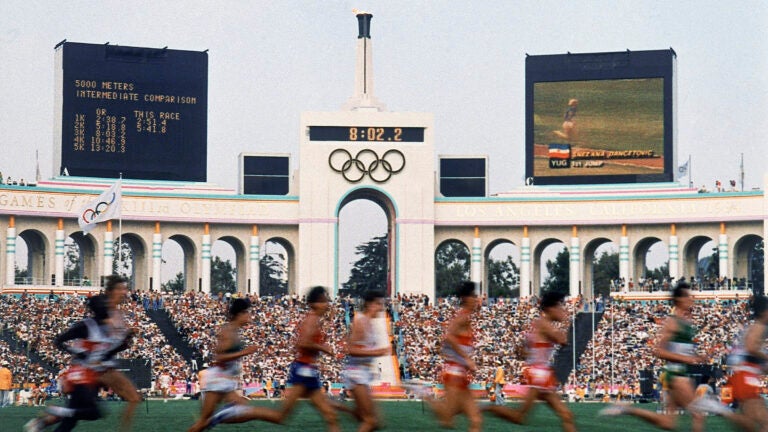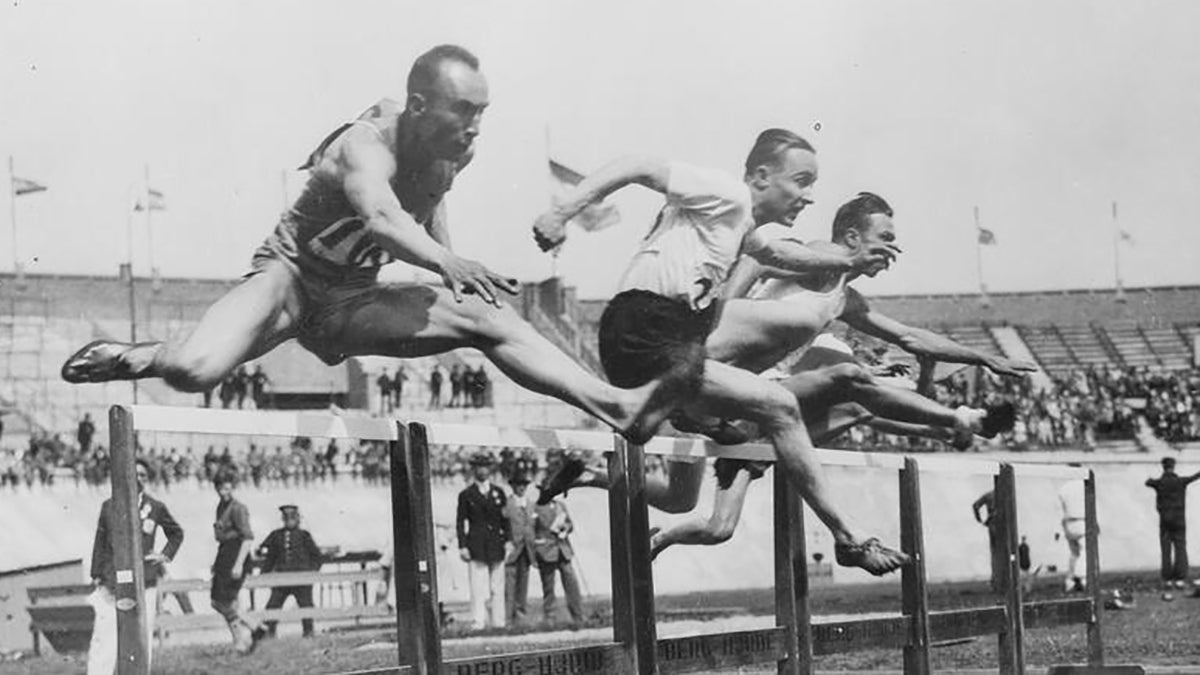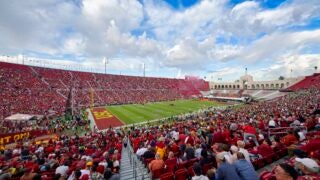
The Los Angeles Memorial Coliseum is the only venue to host the Olympic opening ceremonies twice — in 1932 and 1984. This 1984 photo shows the field of entrants during the men’s 5,000 meters race at the Summer Olympic Games in Los Angeles. (Photo/AP)
From the Olympics to NASCAR, reliving the Los Angeles Memorial Coliseum’s ‘unmatched’ 100-year history
The iconic home of USC Trojan football has seen an unparalleled number of athletic and world events.
When the Los Angeles Memorial Coliseum broke ground in 1921, the city of L.A. had three goals in mind: a centrally located, large event space; a home for USC football; and a memorial to veterans of World War I. It’s safe to say that 100 years later, the stadium has accomplished those goals and more.
“Most people probably only know the Coliseum as the home of USC Trojan football or as host of the Olympics, but it has also been the centerpiece of any type of live event or gathering you could possibly think of,” said Nick Hanneke, manager of event operations at the Coliseum.
The stadium has hosted Super Bowls, National Championship games and the World Series. It has been featured in countless movies and television shows and has hosted musical legends such as the Rolling Stones, U2 and Bruce Springsteen. It’s where presidential nominee John F. Kennedy gave his 1960 Democratic National Convention acceptance speech and Pope John Paul II celebrated mass during his 1987 visit to L.A. The U.S. government designated the stadium a National Historic Landmark in 1984.
As the world sets its eyes on Paris for the 2024 Olympic Games, those associated with the Coliseum have their eyes trained on 2028. As L.A. again plays host to the world, it will also celebrate a milestone: The stadium will become the first venue to host the ceremonies as well as track and field competitions of three Olympic Games.
“The Coliseum is obviously historic, and its long and storied past creates an environment with so much character and charm that cannot be replicated,” Hanneke said. “Very few venues worldwide can boast such an impressive résumé.”
Hosting the Olympic Games

Los Angeles was selected as the host city for the 1932 Olympic Games on April 9, 1923, almost a month before construction on the Coliseum was completed and after the Olympic bid promised a new stadium to accommodate the Games. Nearly a decade later, the L.A. Olympic Games opened to a crowd of 101,022. According to the Coliseum’s official records, 1.2 million fans from all over the world attended the 1932 L.A. Olympic Games, which was roughly the population of the city at that time. These Games also featured the debut of the Olympic Village for the visiting athletes and the three-tier medal podium.
Just over 50 years later, the Coliseum would host its second Olympic opening ceremony in 1984, making it the only venue to do so. To commemorate the Games, composer John Williams created what is now known as the “Olympic Fanfare and Theme” — known as the “Los Angeles Olympic Theme” at the time. The composition has become one of the most recognizable pieces of theme music in sports history.
“The whole building has an aura,” said Anthony Anaya, athletic field supervisor for the Coliseum. “Being on the grass is like sacred ground. You feel like you’re a part of something much larger than yourself.”
With L.A. set to host its first Olympic Games in over 40 years, the Coliseum will again be front and center of the sports world in 2028, albeit with upgrades. In 2019, the stadium underwent an extensive renovation, including construction of the seven-story Scholarship Club Tower — complete with luxury suites, loge boxes, club seats, a state-of-the-art press box and the 1923 Club, a rooftop hospitality deck with a 360-degree view of L.A.
“The renovations completed in 2019 helped bring the Coliseum up to par with many newly constructed venues — there’s that mix of old infrastructure with new, cutting-edge renovations,” Hanneke said.
The original home of L.A. professional football and baseball
Although the Coliseum has become synonymous with USC football, after the Cardinal and Gold most sports fans recall the stadium’s professional football history. The stadium has hosted the L.A. Rams and the L.A. Raiders, as well as two Super Bowls.
As the original professional football team in L.A., the Rams began playing at the Coliseum in 1946 after moving from Cleveland. That same year, the L.A. Dons of the All-America Football Conference also started playing games at the Coliseum. The Dons would continue to call the Coliseum home until 1949, when the league merged with the National Football League and the team merged with the Rams. The latter would call the Coliseum home until 1980, when the Rams relocated to Anaheim.
The Coliseum lacked a professional football team for two years before the Oakland Raiders relocated to L.A. in 1982, followed by the L.A. Express of the upstart United States Football League in 1983. The Express — and the USFL — ceased operations in 1986 and the Raiders moved back to Oakland in 1995, leaving the Coliseum once again devoid of professional football until the Rams moved back to L.A. from St. Louis in 2016.
“As a groundskeeper, just thinking about all the college and NFL teams who have played on our field is incredible,” Anaya said.
Though regarded as one of the premier homes of collegiate and professional football, the Coliseum also housed one of L.A.’s most beloved non-football sports franchises. Before the completion of Dodger Stadium in 1962, the Dodgers called the Coliseum their first L.A. home upon their arrival from Brooklyn in 1958. The following year, the Dodgers defeated the Chicago White Sox in the 1959 World Series, and the Coliseum hosted yet another major sporting event.
“The depth and array of events that the Coliseum has, can or will host is nearly unparalleled,” Hanneke said.
Starting the engines
Converting the Coliseum’s field to support various sports — all with different field dimensions — is challenging enough. But in 2022, the staff at the Coliseum took that concept to unprecedented levels when the field was converted into a racetrack to host its first NASCAR event.
The Busch Light Clash is an exhibition race that kicks off every NASCAR season. For the three races held in the Coliseum in 2022, 2023 and 2024, the building had to be fitted with a temporary quarter-mile track, the smallest track used in NASCAR. In 2022, after 150 laps, Joey Logano edged out Kyle Busch to win the first-ever Clash at the Coliseum, and the stadium itself added another professional sport to its impressive résumé.
“We’ve hosted so many different events here in 101 years,” Anaya said. “Our building’s history is truly unmatched.”
New Video: “We Came To Bring The Fire”
To celebrate the Los Angeles Memorial Coliseum’s 100th anniversary, the stadium partnered with the USC Thornton School of Music, alumni and students to release “We Came To Bring The Fire” last December. The song celebrates the Coliseum’s history — and its relationship with Trojans, whose football team has called the Coliseum home since it opened in 1923.
Ella Collier ’22 and Sam Vendig ’17 sing the track’s main vocals, with the USC choir, GRAMMY nominee Tehillah Alphonso, and Sean Holt, vice dean of the Division of Contemporary Music at USC Thornton, contributing. Stream it here, and watch the just-released music video below.



